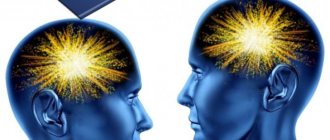Author: ProfGid
From English profile - profile. By the way, in 2022, the ProfGid career guidance center developed an accurate career guidance test. He himself will tell you which professions are suitable for you, and give an opinion about your personality type and intelligence.
A profiler is an expert in detecting lies based on a person’s facial expressions, gestures and manner of speaking.
Technological aspects
The profiler uses in its work the technology of “reading” body language, facial expressions and reading between the lines. For example, there is a suspect who wants to be “attached” with a case of committing a terrorist act. Naturally, when interviewing an investigator, this person monitors his speech and tries to control his behavior. But when the operational worker asks a question regarding the luggage that was left at the station, his eyes are filled with slight anxiety, he almost imperceptibly tenses his hand - this is what an experienced specialist should notice.
The art of identifying the smallest details in the manners and behavior of another person requires considerable knowledge and professional skills from the profiler. It is necessary to clearly understand what exactly you need to pay attention to and what can be relegated to the background. Often in his work, a profiler (verifier) uses a voice recorder or video camera to record a conversation or videotape the situation as a whole. This method works effectively, because with personal contact you can miss seemingly insignificant details, and the film captures everything. After the conversation, you just need to turn on the recording and listen/view it, doing some analysis.
The verifier observes facial expressions, gestures, behavioral characteristics, examines psycholinguistic patterns of speech, paralinguistic signs of verbal production.
The key mission of the profiler is to understand where the lies are. But at the same time, a specialist must understand when a person is sincere. After all, almost each of us, listening to a person whose dialogue is characterized by verbosity, confusion of the story, thoughtfulness over answers, nervousness, will immediately decide that he has become a victim of deception. As practice shows, such characteristics do not mean anything.
Profiler tasks:
- observing people;
- predicting people's actions and behavior;
- unmistakable determination of “empty” words and real human intentions.
A highly qualified profiler is the living equivalent of a lie detector.
Areas of application
Areas in which profiling is in demand:
- Forensics. The method allows you to understand the personal characteristics of serial killers and create their psychological portrait. Includes the application of knowledge from criminology, psychiatry and psychology.
- Special direction. During the Soviet Union, the method was used by KGB officers to identify spies. Today, this area is still relevant and deals with the detection of persons prone to terrorism and extremist activities.
- Aviation. In this area, profiling helps to identify potentially dangerous passengers during pre-flight inspection. Today this method is used in almost all airports in the world.
- Research activities. The main person here is Paul Ekman, a famous American psychologist who studied microexpressions and the definition of emotions. It was thanks to his theory that profiling reached a new level of development and began to penetrate other professional areas. Ekman's research became the basis for training programs for security officers in legal, banking, and government organizations.
- Medical and psychological direction. Based on the research of famous psychiatrists Peter Gannushkin and Karl Leonhard, methods were developed that are widely used in modern psychiatry.
- Psychotechnological sphere. It is this area of profiling that underlies NLP (neurolinguistic programming), the goal of which is to improve the effectiveness of communications between people to achieve what they want. Simply put, subtle manipulation techniques.
The main directions of profiling, or What types of profilers are there?
Business profiling. This is a modern model of conducting business negotiations, in which not only partner parties take part, but also a third party - a profiler. Modern business people know firsthand what this innovation in the business sphere is. This specialist closely monitors his client’s interlocutors. He makes a conclusion regarding the seriousness of his partner’s intentions by assessing his behavior.
Bank profiling. The main character is a bank profiler. What it is? An innovative direction of control and a tool, the use of which allows you to reduce a significant proportion of non-repaid loans. But not everyone knows this. However, it is often possible to see that a profiler is observing the interview of bank employees with a potential borrower who has applied for a loan.
Audit profiling. It has been actively used by various auditing companies to verify the honesty of accounting workers. Now in financial statements they pay attention not only to the equality of debits and credits, but also to the behavior during the next audit of the accountant. This is done by the audit profiler. What it is? Almost all audit firms already know this new “means of protection” against all kinds of fraud in the financial sector and, if possible, are introducing such “innovation” at home. It is worth noting that such a check is an effective addition to the standard check of accounting papers.
Insurance profiling. It is used by insurance companies to prevent or identify all kinds of fraudulent schemes when applying for insurance.
Transport profiling is a way to identify passengers who may pose a danger to the public: mentally unbalanced and aggressive persons, persons carrying one or another weapon, etc. After all, such specialists have abilities that allow them to identify such persons without problems.
Hotel profiling. It is used as a preventive measure to avoid crimes of various types that may occur in the hotel.
Personnel profiling. It consists of “exposing” a candidate for a position and allows you to get to the bottom of what he will not write about himself - gambling addiction, criminal history, presence of particularly large debts, etc.
More recently, such a concept as family profiling was introduced - the ability to recognize the real intentions of the future husband, the difficulties in the life of a teenage son outside the family, and more.
In fact, there are a lot of areas for applying this specialty, and the most interesting thing is that this list continues to grow.
If we take it subjectively, then each of us can distinguish lies in a particular industry.
Where to study a profession
Of course, you need to have a basic education. Without the knowledge that I received at the psychology department, it would have been impossible to do profiling. It is necessary to constantly improve the level of qualifications. I am in correspondence with a community that centers around Paul Ekman, the world's leading expert on the psychology of emotions and lie detection, and consultant on the TV series Lie to Me.
Mostly men work as profilers, because many clients in Russia want to see a representative gentleman. Although women are much more sensitive to lies.
Profiling has not yet been developed in Russia. You can take an express course, where they give a general set of knowledge, recommend literature, analyze video recordings, but this is not a full-fledged training, but rather training that allows employees of organizations that need to be able to recognize lies - banks, insurance companies, and so on - to learn basic things .
How to become a profiler
Profiling is one of the specific forms of activity that combines different branches of the humanities, including art, history and others. Therefore, the future profiler must have a higher or incomplete higher education.
However, there is a fairly widespread opinion that a “live lie detector” must have not only a humanitarian education, but also a basic psychological one. This is explained by the fact that profiling is a psychological science. At the moment, there is no clear answer regarding whether an applicant for the position of a profiler must have such education.
Money
Profilers are paid hourly. The cost per hour depends on the complexity of the order and the authority of the profiler. If we talk about boundaries, participation in an interview costs from 15,000 to 55,000 rubles per hour, in negotiations - from 15,000 to 250,000. Training in the basics of profiling - from 30,000 to 150,000. Depending on how successful the client base has been collected profiler, he can earn from 200,000 per month or more. The best profilers receive offers from abroad, where the income level is even higher.
Knowledge
Working as a profiler implies a clear distinction between truth and lies and their analysis. A “living detector” must have the art of conducting a dialogue in such a way that the interlocutor reveals himself as much as possible both from the verbal side and from the side of gestures and facial expressions.
The profiler must understand:
- Human psychology.
- Emotional psychology.
- Human physiology.
- Emotional physiology.
- Typologies and methods of deception.
- Signs of deception are not only in speech, but also in facial expressions and movements.
- Techniques and methods for detecting deception.
Prospects
There are a maximum of five good profilers in Moscow. This is a fairly narrow specialization, and people who have the necessary skills are very highly regarded. More and more people are becoming interested in profiling, although, of course, not everyone is able to master the profession. The demand for profiling training is growing especially quickly, but most graduates of such academies still do not choose profiling as their main activity, but use their skills at work: in the human resources department, in a bank, in security services. The demand for profiler services is growing steadily.
Text: Siranush Sharoyan
Photos: Ksenia Kolesnikova
Skills
The profiler is responsible for:
- Organization and conduct of observations.
- Determination of a person’s psychotype based on external characteristics and behavioral characteristics.
- Identification of lies and truth, based on the technique of statements and speech construction.
- Finding one or another emotion of the interlocutor in microexpressions.
- Distinguishing blurred emotional expressions.
- Difference between gestures-emblems and gestures-illustrators.
- Finding leaks of reliable information.
- Using lie detection techniques.
Useful tips
So how do you become a profiler? Just follow a few simple tips:
- Prepare for the conversation in advance. Try to find out as much as possible about your interlocutor. Find out about his interests, hobbies, interests, values and views. If possible, explore his social media. If preliminary preparation is impossible for some reason, try talking on neutral topics.
- Ask more questions. Often people leave things out or generalize. Therefore, ask clarifying questions until you see the full picture. And remember: there should be one answer to one question. You should not go into details or indulge in lengthy discussions if they are not necessary.
- Be as focused and attentive as possible. Pay attention to gestures, facial expressions, intonation and other points.
- Don't jump to conclusions. Analyzing the information received is the most difficult thing. Therefore, do not rush, do not label a person. Think about why he gave this or that reaction. And then choose the option that suits the given situation most.
And the last piece of advice is to watch. Be careful, because the interlocutor can manipulate you, trying to evoke some emotions, for example, anger, shame, guilt or, conversely, joy and euphoria. In this state, you will not be able to adequately perceive information.
We identify and optimize resource-intensive 1C:Enterprise queries
Mediator h&f talks about professions that will be in demand in the future.
today Usually the subject of optimization is predetermined key operations, i.e. actions whose execution time is significant for users. The reason key operations are not performed quickly enough may be suboptimal code, suboptimal queries, or concurrency problems. If it turns out that the bulk of the execution time of a key operation is spent on queries, then these queries are optimized. With high loads on the DBMS server, those queries that consume the most resources also need optimization. Such requests are not necessarily related to key operations and are not known in advance. But they are also easy to identify and determine the context of their execution in order to optimize using standard methods.
Mark Knapp, Judith Hall “Nonverbal Communication”
The authors tried to reveal all aspects of nonverbal human behavior. This work explains what nonverbalism is and where it is used; it describes in detail such manifestations as:
- facial expressions;
- pantomime;
- voice pitch;
- appearance;
- touching;
- views;
- location in space.
It tells you in a simple and accessible way how to speak body language and use its signals.
Knowing all the features of nonverbal language, it will be easier for you to understand how to improve the quality of communication, who is blatantly lying to you, and how to protect yourself from hostile people. Suitable for anyone who frequently communicates with people.
FAQ
Will I be able to read people after learning profiling?
To “read” people, it is not enough just to read an intelligent book. To “scan” a person you need to know the basics of psychology and be able to observe. Only in this case will it be possible to find out about a person what he is hiding.
Is it possible to determine by gestures whether a person will set me up or not?
Will he set you up or won't you set him up, no gestures are shown. But, knowing the basics of profiling, you will be able to predict a person’s behavior: whether he is deceiving you, whether he is ready to sincerely communicate with you or not. This science provides such data.
Will knowing profiling make my life easier?
This knowledge is universal. And they really make life easier. Forecast and knowledge of human psychology help prevent some mistakes or, conversely, provoke him to openness. You need to develop and study profiling even for everyday life.
Paul Ekman, Wallace Friesen “Know a Liar by Their Facial Expression”
This is the next most important book in profiling. It is a continuation of the first
The facial expressions of the main 7 emotions are described here in great detail. The authors describe in detail the smallest manifestations of insincerity and lies.
Here you will find a detailed guide on how to determine emotions on the face and how they are masked by a person.
Emotions are a path to understanding a person, a signal of danger, desire and a certain feeling. The manual helps you read your interlocutors literally by their faces. It will become your faithful advisor, telling you who to have a good relationship with and who not to open up to. This is a detailed guide to how to respond to anger, contempt and resentment.
Classification of personality psychotypes in profiling
Professional profilers classify people into 8 main psychotypes:
- Hysteroid. Such a person is distinguished by demonstrative behavior. The main thing for a hysteroid is attention, which he is able to achieve by any manipulation. He clearly shows his strengths, admires himself and his vices. Compliments make him happy, but lack of attention makes him feel deprived. Loves aesthetics in appearance and everyday life.
- Epileptoid. A person of this type likes to influence other people and strives for power and control. At the same time, he feels the limits of what is permitted and does not allow himself to go beyond them. Also does not tolerate pressure on himself. Unlike the hysteroid, the epileptoid does not show off his merits and does not set himself the task of achieving universal recognition. His own respect is enough for him. This is a reliable person who values friendship, but does not always know how to control negative emotions.
- Paranoid. He has a disruptive character, a high level of energy and a desire for personal effectiveness. It charges itself quickly and charges everyone around it. Disadvantages of this type: impatience of criticism from others, stubbornness and imperviousness to feedback.
- Emotive. Such people feel increased responsibility for others; they are overly sympathetic and understanding. They feel sorry for their whining friends, homeless animals, and hungry children. They are easy to manipulate. The appearance of emotive personalities is characterized by modesty, inconspicuousness, and naturalness.
- Hyperthym. Considered the happiest personality type. His hormonal background allows him to almost always be in a good mood. Such a person is the soul of any company, he easily finds a common language with a wide variety of people, he is cheerful and active. Disadvantages of hyperthym: high distractibility, it is difficult for him to concentrate on routine tasks, he is not too susceptible to other people's experiences.
- Schizoid. A person prone to reflection and reflection. Such a person is able to think through various technologies, he constantly scrolls through a large amount of information in his head, analyzes and evaluates his own and others’ behavior. He is process oriented rather than result oriented. Appearance is not very valuable to him.
- Anxious and suspicious. A person of this type can be unbalanced by any remark, pressure or personal failure. Frequent worries take away a lot of his energy and desire to work. At the same time, he also has advantages: high empathy, a sense of justice, perseverance, exactingness, perseverance in achieving results.
- Depressed and sad. A loner who prefers reading books and watching movies to real communication with people. Very restrained and careful, weakly susceptible to other people's problems and pains.
Despite the fact that this classification is simple and convenient in practical use, it is still a simplified model. Unambiguous assignment of a person to one type or another is possible only after careful research and observation.
I recommend reading what other types of human personality are distinguished in psychology and socionics.
What it is
Sometimes you can meet individuals who, almost at one glance, can understand what their opponent is like. And this is not a superpower, it is just observation and the ability to correctly analyze the manner of communication and other inconspicuous behavioral characteristics that reveal much more about the interlocutor than he himself would like to say. Some people read such information intuitively, while for others there is a scientific technology called “profiling”, the tasks of which include the study of implicit signals present in the communication behavior of each individual.
So what is profiling? Simply put, this is a set of methods that help analyze the character of individuals and predict a behavioral model based on various indirect signs (non-verbal signals). Typically, the profiling process involves creating a psychological profile that outlines key character traits.
True profiling assumes that there is an established relationship between a certain trait and the existence of a corresponding character trait. Having established the type of person, determining his individual psychological characteristics, a fairly accurate and detailed psychological profile is compiled, according to which specialists can relatively accurately predict the individual’s further actions, find weak points and select a technique for influencing or interacting with the subject being analyzed.
Profiling techniques were originally used by security at an Israeli airport. The profiler’s task was to analyze the behavioral model of passengers and identify potentially unsafe subjects with hidden weapons or ammunition. The implementation of the considered set of technologies has yielded positive results. Today this airport is considered one of the safest.
Further, personality profiling continued its development, complemented by the latest techniques and methods, and also began to be used in other areas - in business, forensics, consulting, and recruiting.
Examples of decoding gestures and behavior
I propose to take a little look behind the scenes of profiling and see what actions and signs may indicate that a person is lying:
- frequent touching of the tip of the nose with your hand;
- uncontrolled movements of the hands near the face - rubbing the temples, eyelids, covering the mouth with the palm, stroking the chin, forehead, lips;
- intense rubbing of hands;
- tapping your feet on the floor, tucking them under you;
- closed pose - crossed legs or arms;
- unconscious keeping of distance – bending the body, stepping back, moving the chair;
- pulling the collar of clothing.
It is important to remember that deception is revealed by tracing the entire chain of actions. So it is impossible to judge the reliability of information by one gesture.
When a person talks about something or answers a question, you can determine by the movement of his eyeballs whether he is remembering the events or making them up. If the eyes move up and to the left, then this means that he is remembering, up and to the right - he is lying and inventing.
In addition to gestures and behavior, it is important to pay attention to other signs, for example:
- Speech. How its speed, volume, length, coherence, vibration changes.
- Eye contact. Facial expression, naturalness of a smile, frequency of blinking, sweating, swallowing saliva.











